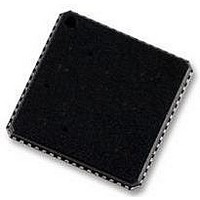ADSP-BF592KCPZ Analog Devices Inc, ADSP-BF592KCPZ Datasheet - Page 12

ADSP-BF592KCPZ
Manufacturer Part Number
ADSP-BF592KCPZ
Description
58T4522
Manufacturer
Analog Devices Inc
Specifications of ADSP-BF592KCPZ
Operating Temperature (min)
0C
Operating Temperature (max)
70C
Operating Temperature Classification
Commercial
Mounting
Surface Mount
Pin Count
64
Rohs Compliant
YES
Frequency
400MHz
Embedded Interface Type
PPI, SPI, UART
No. Of I/o's
32
Operating Temperature Range
0°C To +70°C
Digital Ic Case Style
LFCSP
No. Of Pins
64
Core Supply Voltage
1.4V
Lead Free Status / RoHS Status
Compliant
Available stocks
Company
Part Number
Manufacturer
Quantity
Price
Company:
Part Number:
ADSP-BF592KCPZ-2
Manufacturer:
BROADCOM
Quantity:
154
ADSP-BF592
INSTRUCTION SET DESCRIPTION
The Blackfin processor family assembly language instruction set
employs an algebraic syntax designed for ease of coding and
readability. The instructions have been specifically tuned to pro-
vide a flexible, densely encoded instruction set that compiles to
a very small final memory size. The instruction set also provides
fully featured multifunction instructions that allow the pro-
grammer to use many of the processor core resources in a single
instruction. Coupled with many features more often seen on
microcontrollers, this instruction set is very efficient when com-
piling C and C++ source code. In addition, the architecture
supports both user (algorithm/application code) and supervisor
(O/S kernel, device drivers, debuggers, ISRs) modes of opera-
tion, allowing multiple levels of access to core
processor resources.
The assembly language, which takes advantage of the proces-
sor’s unique architecture, offers the following advantages:
DEVELOPMENT TOOLS
The processor is supported with a complete set of
CROSSCORE® software and hardware development tools,
including Analog Devices emulators and VisualDSP++® devel-
opment environment. The same emulator hardware that
supports other Blackfin processors also fully emulates the
ADSP-BF592 processor.
EZ-KIT Lite® Evaluation Board
For evaluation of the ADSP-BF592 processor, use the EZ-KIT
Lite boards soon to be available from Analog Devices. When
these evaluation kits are available, order using part number
ADZS-BF592-EZLITE. The boards come with on-chip emula-
tion capabilities and are equipped to enable software
development. Multiple daughter cards will be available.
DESIGNING AN EMULATOR-COMPATIBLE
PROCESSOR BOARD (TARGET)
The Analog Devices family of emulators are tools that every sys-
tem developer needs in order to test and debug hardware and
software systems. Analog Devices has supplied an IEEE 1149.1
• Seamlessly integrated DSP/MCU features are optimized for
• A multi-issue load/store modified-Harvard architecture,
• All registers, I/O, and memory are mapped into a unified
• Microcontroller features, such as arbitrary bit and bit-field
• Code density enhancements, which include intermixing of
both 8-bit and 16-bit operations.
which supports two 16-bit MAC or four 8-bit ALU + two
load/store + two pointer updates per cycle.
4G byte memory space, providing a simplified program-
ming model.
manipulation, insertion, and extraction; integer operations
on 8-, 16-, and 32-bit data-types; and separate user and
supervisor stack pointers.
16-bit and 32-bit instructions (no mode switching, no code
segregation). Frequently used instructions are encoded
in 16 bits.
Rev. A | Page 12 of 44 | August 2011
JTAG Test Access Port (TAP) on each JTAG processor. The
emulator uses the TAP to access the internal features of the pro-
cessor, allowing the developer to load code, set breakpoints,
observe variables, observe memory, and examine registers. The
processor must be halted to send data and commands, but once
an operation has been completed by the emulator, the processor
system is set running at full speed with no impact on
system timing.
To use these emulators, the target board must include a header
that connects the processor’s JTAG port to the emulator.
For details on target board design issues including mechanical
layout, single processor connections, multiprocessor scan
chains, signal buffering, signal termination, and emulator pod
logic, see (EE-68) Analog Devices JTAG Emulation Technical
Reference on the Analog Devices website (www.analog.com)—
use site search on “EE-68.” This document is updated regularly
to keep pace with improvements to emulator support.
RELATED DOCUMENTS
The following publications that describe the ADSP-BF592 pro-
cessor (and related processors) can be ordered from any Analog
Devices sales office or accessed electronically on our website:
RELATED SIGNAL CHAINS
A signal chain is a series of signal conditioning electronic com-
ponents that receive input (data acquired from sampling either
real-time phenomena or from stored data) in tandem, with the
output of one portion of the chain supplying input to the next.
Signal chains are often used in signal processing applications to
gather and process data or to apply system controls based on
analysis of real-time phenomena. For more information about
this term and related topics, see the “signal chain” entry in the
Glossary of EE Terms
Analog Devices eases signal processing system development by
providing signal processing components that are designed to
work together well. A tool for viewing relationships between
specific applications and related components is available on the
www.analog.com
The Circuits from the Lab
provides:
• Getting Started With Blackfin Processors
• ADSP-BF59x Blackfin Processor Hardware Reference
• Blackfin Processor Programming Reference
• ADSP-BF592 Blackfin Processor Anomaly List
• Graphical circuit block diagram presentation of signal
• Drill down links for components in each chain to selection
• Reference designs applying best practice design techniques
chains for a variety of circuit types and applications
guides and application information
website.
on the Analog Devices website.
TM
site (www.analog.com\circuits)














